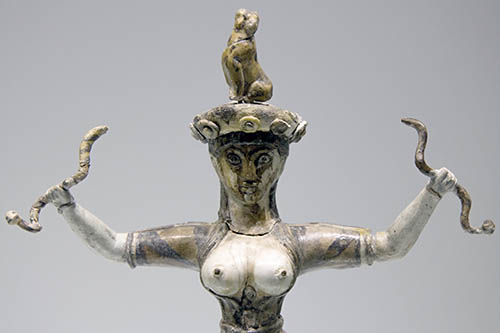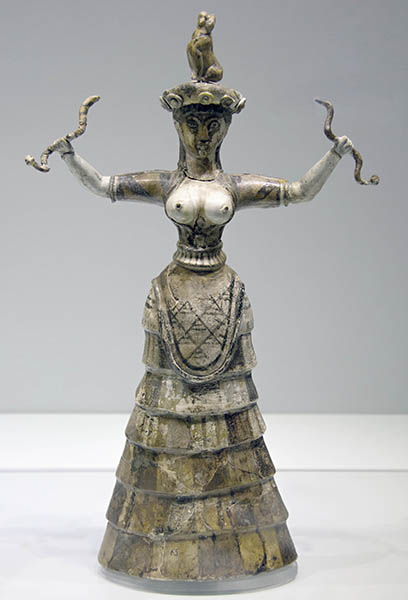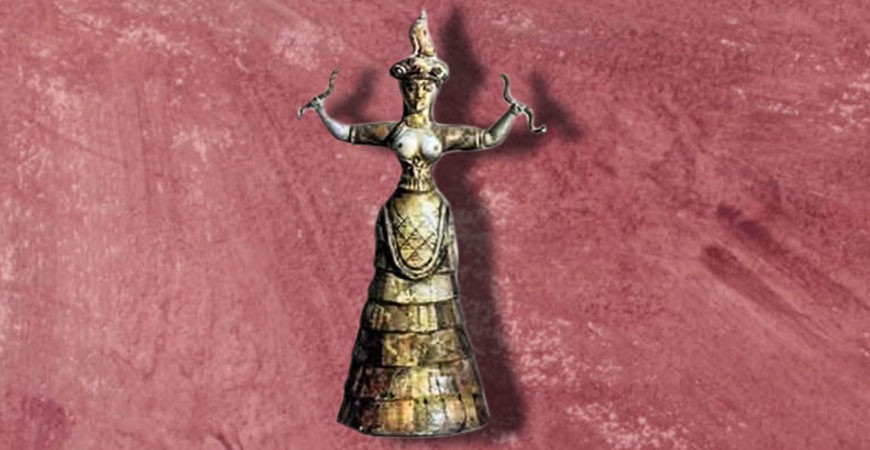The poem begins with the speaker describing coming upon the snake in his pyjamas. What is the meaning of the The Snake Goddess.

Snake Goddess Article Minoan Khan Academy
The complete right arm held a short wavy striped stick which Evans interpreted as a snake.

. This was in some measure to match the other nearly complete figurine found in the Temple Repositories which clearly had snakes slithering up both of her arms. Since the beginning of the world the serpent. Critical Analysis of Snake by DHLawrance.
The Cretan Snake Goddess The smaller of the two statues of the snake goddess the one holding two snakes one with each hand. The faïence figurine was made between 1600-1580 BCE and the creator remains unknown. The snake goddess seemed to fit the mood at the beginning of the twentieth century when the Western world was looking for origins although a few voices raised some doubts at its modern look.
However a majority of perceptions would all agree that the Snake Goddess is an. However its similarity to the three pieces that were excavated from the Temple Repositories and the desire to accept it as authentic silenced these doubts. Two of these statuettes were extensively restored and identified by Evans as a Mother Goddess and a Priestess.
Part of the attraction of the figurines is that they can be interpreted as embodying many of the perceived and admired characteristics of the Minoans. It is considered to depict the ground goddess of a snake maybe the daughter of the goddess. Also common are legends of encounters with snake-like creatures in folklore like Melusine.
It also symbolizes immortality as it was thought to shed its skin indefinitely. In the 1951 essay About Ed Ricketts published as part of The Log from the Sea of Cortez John Steinbeck records his recollection of the composition of his short story The Snake and identifies the occurrence as an actual event that happened one night in his friend Rickettss. April 27 2016 by Website Contributors.
Imagery of two intertwined serpents is associated with this snake goddess while her major themes include rebirth and the transformation of the spirit throughout lifes journey. Snake is probably D. Snake by DH.
The actual representation of the Snake Goddess is unknown. Lawrence wrote Snake while he was living on the island of Sicily in the beautiful resort Taormina on the east side of the island. Celtic Snake Goddess.
The serpent is a totem of the cycles of life death and rebirth and the seasons. The Snake Goddess Analysis. Their elegant fashionable costumes their physical gracefulness their sensitive yet forthright personalities their sophisticated tastes and love of luxury their refined manners and worldly.
Minoan Snake Goddess ca. The Snake Goddess a voluptuous divine figure with bare breasts and snakes in both hands is one of the most well known female deitys and faïence figurines in Minoan culture Patron. Other examples of this motif have since been discovered reinforcing the idea that the small sculpture portrays a deity of some kind.
Wears a chapeau with a sitting cat on top and has exposed bare chests Witcombe The fact that she is depicted partly bare. While the Minoan Snake Goddess is one of the most reproduced and familiar images in the art historical canon her functionand indeed her very essencecontinues to be shaped by the man who coined the term Minoan and discovered the site in which she and her sisters lay for generations undisturbed. However Lawrence feels that this is a most unjust way to treat the snake.
It is the connection to the fertile earth and to the underworld. Critical Analysis- The snake is generally seen in a negative way by man. Analysis of John Steinbecks The Snake By NASRULLAH MAMBROL on June 14 2021.
In 1903 British archaeologist Arthur Evans found the faïence figurine which is known as The Snake Goddess in Minoan archaeological sites in Crete. Today little is known about the actual representation of the faïence figurine however evidence supports that The Snake Goddess symbolizes fertility holiness and life and death Flamee. One of the most forgotten goddesses of the Celtic pantheon Corra is the embodiment of life death fertility and the earth itself.
Although pleased to see the animal and more than willing to. Irish culture is brimming with myths and legends perhaps none so prevalent as that of St. Snake is conversational in tone which makes it reasonably accessible.
She was born in the Minoan period and probably represents the culmination of the cult of the Serpent Goddess. The actual representation of the Snake Goddess is unknown. Man is taught to be afraid of it and to kill it if they encounter it at any point.
These figures became iconic images of Minoan civilization as soon as they were published and ever. The Snake Goddess in Minoan Culture. Patrick Irelands patron saint banishing.
The theory of the sculptures. The Snake Goddess a voluptuous divine figure with bare breasts and snakes in both hands is one of the most well known female deitys and faïence figurines in Minoan culture Patron. The Snake Goddess holds a serpent in each manus.
Lawrence describes a speaker s various interactions with a snake that came to drink at his water-trough. Snake gods and snake goddesses are common among the most ancient gods of the world. The Snake Goddess The Snake Goddess a voluptuous divine figure with bare breasts and snakes in both hands is one of the most well known female deitys and faïence figurines in Minoan culture Patron.
Nevertheless some words of analysis on the poems language and meaning may be. The unity of the Great Goddess becomes divided in Greek mythology. In 1903 Sir Arthur Evans excavating at the palace of Knossos on the island of Crete discovered fragments of faience statuettes depicting female figures holding snakes.
The Snake Goddess as originally excavated lacked a head and half of her left arm. The most prominent way The Snake. He was unprepared to see it but immediately happy it was there.
When Sir Arthur Evans concluded. However a majority of perceptions would all agree that the Snake Goddess is an important female deity in Minoan civilization. With her chests uncovered is interpreted as a mark of.
This figurine of a woman holding a snake in either hand with a cat sitting on top of her head was discovered by Arthur Evans in the original excavation of the Pallace of Knossos.

Snake Goddess Article Minoan Khan Academy

Snake Goddess Article Minoan Khan Academy

Minoan Goddess With Snakes History Meaning Culturetaste Blog
0 Comments